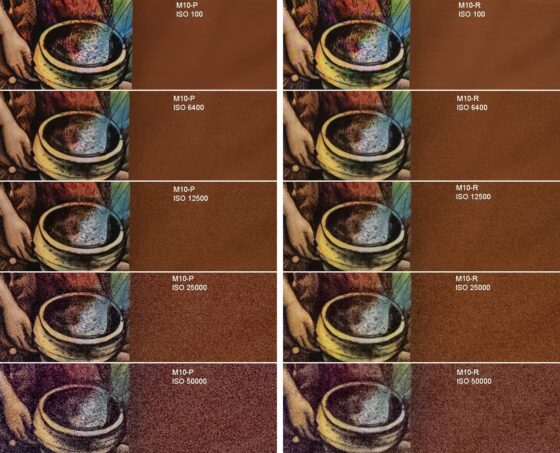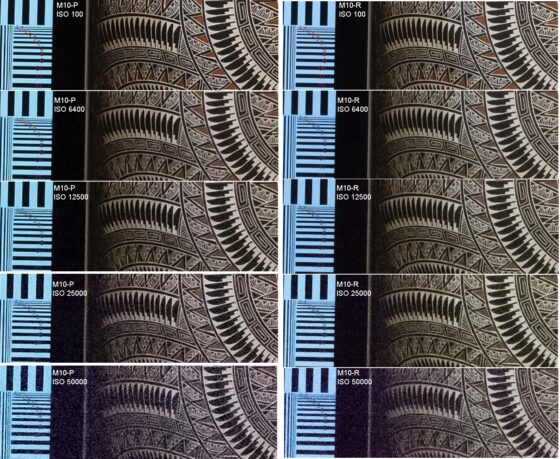Leica M10-R vs Leica M10-P ISO sweep, acuity, and noise side-by-side comparison
By Onasj (see previous articles by Onansj)
I obtained a customer-release—not pre-release/beta—M10-R and compared it side-by-side with the M10-P on a test scene. The firmware version for both was the latest firmware currently available to the public: 10.20.27.20 for the M10-R (upgraded from the initial released 10.20.23.49 firmware that was pre-installed in the new camera), and 2.7.5.0 for the M10-P.
Methodology: all shots were taken on a tripod with a 2-second delay to minimize vibration. The same Leica 50 APO lens was used for all tests. The aperture was set to f/5.6 for all tests, at which the resolving power of the 50 APO is about as high as possible among commercially available 35-mm format lenses. The ISO value and shutter speeds were as follows:
ISO 100, 1 s
ISO 6400, 1/60 s
ISO 12500, 1/125 s
ISO 25000, 1/250 s
ISO 50000, 1/500 s
To the best of my ability, the M10-P and the M10-R were treated equally. The test shots were taken in one sitting, with the same tripod position ~1.3 m from the target, and under the same lighting. The images were focused by rangefinder and confirmed by live view for each camera, and the distance setting of the lens was indistinguishable when mounted to each of the two cameras.
To keep the test as pure as possible, all the test shots were taken as DNG files, then transferred and opened in Adobe Photoshop 2020 with Camera Raw 12.3 (which has native M10-R support) into JPEG files with no corrections or adjustments to the default image settings. Therefore, this test does not really answer the question of how the performance between the cameras compares if one were to bring the full power of modern post-processing, color correction, noise removal, AI-driven scaling and sharpening, etc. to bear on the images. It simply informs how the basic raw-file captures from the cameras compare. I did open the DNG files in Capture One 20 Pro as well, but immediately found that while the M10-P files had accurate color when opened by Capture One (noticeably better than Adobe conversions, in fact!), the M10-R files opened in Capture One were substantially off in color. Therefore:
Finding #1: For now, if you have a choice, use Adobe with fully updated Camera Raw (12.3 or later) to open your M10-R DNG files, not Capture One 20 Pro.
All the resulting RAW files and JPG files can be downloaded here.
How to handle the different image sizes from the two cameras? There’s no one right answer to this question, but in order to preserve the extra information in the M10-R files, I decided to use Photoshop to scale the M10-P files up to the same width (7864 pixels) as the M10-R files for all side-by-side comparisons. You can download the scaled-up M10-P JPG files from the link above. I also compared at full-screen size all test images, and I generally found the same trends and conclusions in viewing the images at full-screen size as viewing the images at 7864 pixels wide at any higher magnification level up to 100%
Here’s the uncropped test image:

The iPad is an 11” iPad Pro, with a custom test image that is the exact size of the display (2388 x 1688) that shows a series of lines ranging from 1 pixel wide to 20 pixels wide, by increments of 1 pixel width. This device has a screen size that results in 264 dpi—what Apple calls a “Liquid Retina display”, so the smallest 1-pixel-wide lines are 1/264” wide each, and are barely resolvable by a pair of healthy naked eyes at a typical reading distance. The vessel is exquisitely carved by Marvin Blackmore. The cards feature the art of Chris-Anne Donnelly.
Below are 100% crops of two regions from the scaled-up M10-P files and the M10-R files, one close to the center of the frame, and one from the outer third of the image. The first crop includes a part of the image with a variety of colors and background wall shadow levels and thus is useful for evaluating color and shadow noise. The second crop includes a part of the image with fine detail and thus can be used to evaluate acuity.
Here is a comparison matrix of crops from the color/background noise part of the test scene:

Finding #2: Scaled to the same image size, the M10-R offers less-pronounced background noise than the M10-P at the same high ISO level (~12500+).
In this part of the image, the extent to which the background noise is noticeable to my eye is the almost a full stop better for the M10-R than the M10-P—compare the M10-R at ISO 12500, 25000, and 50000 to the M10-P at ISO 6400, 12500, and 25000. The color saturation suffers around ISO 25000 for both cameras. Note that the color saturation from the workflow used in this test results in slightly higher saturation levels in the M10-P images, even at ISO 100. I was able to restore color saturation in post-processing for even the ISO 50000 images for both cameras—indeed, simply clicking the “Auto” button in Adobe Camera Raw/Photoshop did a good job restoring lost color.
Here is a comparison matrix of crops from the acuity part of the test scene:

Finding #3: In general, the M10-R shows higher acuity than the M10-P, as expected given its higher resolution.
I was especially impressed with how well the M10-R held details even at very high ISO values. The M10-R image even at ISO 25000 is able to resolve the two single pixel-wide lines on the iPad, while the M10-P can’t really resolve these two lines at any ISO. Other fine details in the carved vessel are also captured by the M10-R but are either not captured or poorly captured by the M10-P.
Finding #4: Scaled to the same image size, the M10-R offers acceptable levels of acuity and noise at higher ISO values than the M10-P.
While the threshold of “acceptable” differs based on subject, viewing size, photographer, and viewer taste, to my eye the M10-R offers good images at ISO 12500 and possible usable images at ISO 25000, while the M10-P appears to lag approximately half a stop behind in the high ISO range tested (6400-50000). Of course if one were to examine the unscaled M10-P files at 100% and compare them with the larger M10-R files, the M10-R loses some of its advantage, but as I explained in earlier posts, comparisons of two cameras really should be done at the same viewed or printed image size, not at different image sizes.
Overall, I’m impressed with both the acuity and high-ISO performance of the M10-R.
Related posts:
Leica M10-R vs Leica M10-P shadow and highlight recovery side-by-side comparison
Leica M10-R vs Leica M10 Monochrom high-ISO acuity and noise side-by-side comparison
Leica M10 vs. Leica M10P vs. Leica M10M vs. Leica M10R specifications comparison














